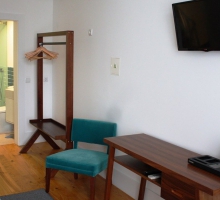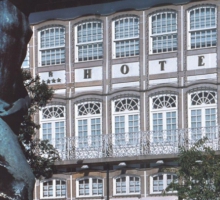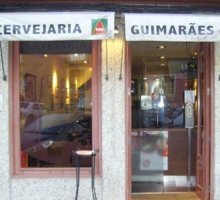The Archaeological Nucleus of ACIG emerged as a social responsibility initiative. During the remodeling and rehabilitation of its headquarters building, Casa dos Lobo Machado, archaeological surveys were carried out. The main result was the appearance of a vast collection, both in terms of chronology and the type of pieces.
In this sense, it was created the exhibition spaces that, being open to the general public, allow to make known a little better the past of Guimarães.
Part of the Visiting Collection exhibited in the Archaeological Nucleus of ACIG is a total of 30 pieces, of which 23 are ceramic pieces and 7 are metallic pieces.
The 23 ceramic pieces are divided into 3 distinct chronological groups. A first group of 7 pieces is formed by the medieval ceramics, dating from the late thirteenth and early fourteenth century. It consists of parts that should have been mostly produced in the Prado / Barcelos region. In this group, an infuse of French origin stands out.
The second ceramic group, with a total of 11 pieces, dates from the second half of the eighteenth century. In this case, the variety of forms and productions is greater than in the previous group. In it are pieces coated with lead glaze, faience and pieces of common use. With regard to shapes, we have, among others, bowls, cakes, saucers and dishes.
From the third group of ceramics, dating from the end of the 19th century, pieces probably produced in Guimarães, such as pitchers and a pot to go to the fire. Of this group, two glass towers, possibly produced in the Prado / Barcelos area, stand out.
Finally, within the metallic objects, objects of adornment, like a ring, some coins and a votive medal can be seen. An interesting piece of this group is a small rattle, probably for a cat, made of copper and silver alloy.
Location: Guimarães
In this sense, it was created the exhibition spaces that, being open to the general public, allow to make known a little better the past of Guimarães.
Part of the Visiting Collection exhibited in the Archaeological Nucleus of ACIG is a total of 30 pieces, of which 23 are ceramic pieces and 7 are metallic pieces.
The 23 ceramic pieces are divided into 3 distinct chronological groups. A first group of 7 pieces is formed by the medieval ceramics, dating from the late thirteenth and early fourteenth century. It consists of parts that should have been mostly produced in the Prado / Barcelos region. In this group, an infuse of French origin stands out.
The second ceramic group, with a total of 11 pieces, dates from the second half of the eighteenth century. In this case, the variety of forms and productions is greater than in the previous group. In it are pieces coated with lead glaze, faience and pieces of common use. With regard to shapes, we have, among others, bowls, cakes, saucers and dishes.
From the third group of ceramics, dating from the end of the 19th century, pieces probably produced in Guimarães, such as pitchers and a pot to go to the fire. Of this group, two glass towers, possibly produced in the Prado / Barcelos area, stand out.
Finally, within the metallic objects, objects of adornment, like a ring, some coins and a votive medal can be seen. An interesting piece of this group is a small rattle, probably for a cat, made of copper and silver alloy.
Location: Guimarães




